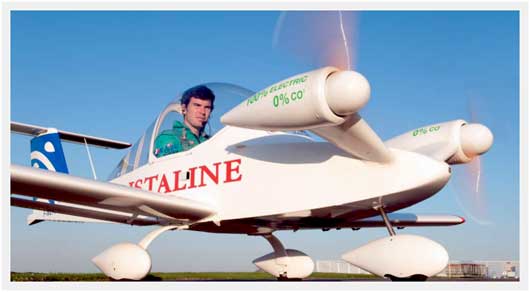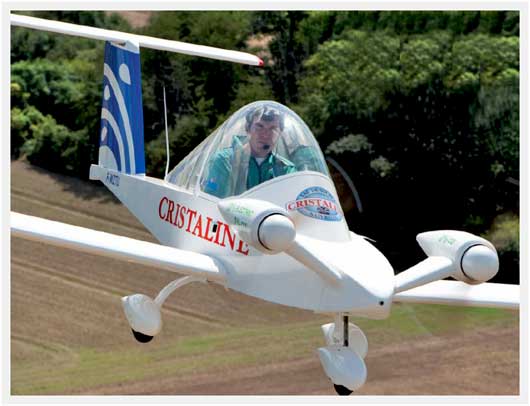Everybody's Doing The Electric Cricket!
 Friday, December 24, 2010 at 09:07AM
Friday, December 24, 2010 at 09:07AM  Hugues Duval in a Cri Cri aircraft powered by two 35 hp Electravia electric motors
Hugues Duval in a Cri Cri aircraft powered by two 35 hp Electravia electric motors
Ok, maybe not 'everybody', but first it was Aerospace giant EADS building the little 4-motor electric Cri Cri and then right on their heels was this one pictured here that uses two 35 hp electric motors from Electravia. Both actually had their first flights back in September. Kinda interesting that one of the smallest airplanes in the world has already been so successful at demonstrating the flight potential of electric power systems.
BTW, when the 'Cri Cri' first appeared from French designer Michel Colomban in 1973, the name Cri Cri was also known to be interchangeable with 'Cricket'. I wasn't able to confirm exactly how the two words are connected (I've seen several different stories) but regardless of which name you use, you're talking about one of the most unique aircraft ever designed and built. I can still remember the unbelievable sight of two Crickets doing some pretty hardcore low-level aerobatics at Oshkosh in 1981... still one of the most impressive aerial displays I've even seen!
The real story here however is the electric propulsion systems. We're seeing several innovative ideas pop up around the world showing the potential of electric power for flight, but there's something extra encouraging to me to see this very familiar airframe so effectively adapted to it. It's almost getting easy to imagine that before long we'll see amazingly affordable and effective 'sport flying' machines readily available. In fact, the 'sport flying' segment is probably the perfect place for this technology to get an initial grip. Battery technology right now is still gonna keep overall run time fairly short, which is very well suited to the guy just looking for 30 minutes to an hour of cheap fun flying. And, with the relatively low power output motors that are currently available, smaller single seat airplanes are the best fit for these quiet powerplants.
 Hugues Duval and the electric motor powered Cri Cri in flight
Hugues Duval and the electric motor powered Cri Cri in flight
The rapid pace that things are changing is certainly making it seem possible that electric propulsion systems large enough for even 4-place aircraft may not be as far away as we thought just a few years back. In fact, the electric powered Cessna 172 concept from Bye Energy is a strong first step in that direction. That project, which includes participation from Cessna, is aimed at eventually getting an STC for the conversion which would make a 2-seat trainer that could fly for 2 hours and use no avgas at all. The concept seems to make sense... and it's unique applications like this that will slowly open the door for electric airplanes (and advancing motor and battery technology) to get a foothold into a market desperately in need of innovation.
The biggest challenge for electric power for aviation seems to come from dealing with what to do about 'refueling' while on longer flights, or when traveling great distances. The infrastructure needed for replaceable batteries, or the technology advances required for 20 minute re-charging seem to be a really long way off. But overall, the progress already seen is pretty exciting.
Lastly, it's interesting to note that the Cri Cri pictured here, with the Electravia motors totaling 70 hp, wasn't just barely able to get off the ground, it actually reached 162 mph, essentially the airframe's maximum design speed! They claim that using full power would have propelled it all the way up to 220 mph! When you consider that the Cri Cri is far from a 'motorglider with a massive wing', you can see that realistic applications for normal airframes powered by the electron are definitely on the horizon. I think I'm pretty happy about that... I wouldn't mind doing the little electric Cricket myself : )














































































Reader Comments (6)
0% Co2 ? That's a miracle in itself. How are they charging the batteries ? ; )
seerjfly- I think they're using athletic hamsters (fed organic rainwater-only foods) turning cages connected to generators to get their electricity for the batteries... ok, not so much! But, while I'm sure there's CO2 produced in making the electricity, at least the motors on the airplane aren't making any. We don't usually take into account that which is produced by refining gasoline either, only what is produced by the engines.
As a side note, I'm not really concerned about CO2 emissions either way as I have never believed the global warming issue to be based in fact. I do like efficient, powerful, clean and affordable ways to spin a prop tho, and that's why I like the direction we're headed : )
I think that electric engines are a good idea on planes with low weight and lift to drag ration above 30. Otherwise, the range will be too limited.
Martt, just a statement of ironicalness and retorical question on my part. I'm in your corner on AGW, we are but a zit on the derrier if the earth. It just eats at me that 'other' people don't know where electricity actually comes from. Y'know, the people who think beef comes from the store, no cows,pigs or chickens are killed in the production of your meal. I love this site, keep having fun with it. Hope to meet you at OSH next year as I have a sandwich or two awaiting me. :oD
Merry Christmas, Bob
P.S. I poo-pooed electric R/C back when, love it now. Looking forward to the future of homebuilding, an EAA'er will be the first to make elec. flight practical. Mark my words.
seerjfly- Great points, I agree all around... and Merry Christmas to you too : )
Hi Martt,
I hate to be the negative guy but I'm thinking we'll see electric airplanes become practical about the same time the airplane in every garage happens. I think they've been predicting that one for about 60 years or more.
The electric morors will be work fine and be fun, but I wouldn't want to get too far from home base.
Milford